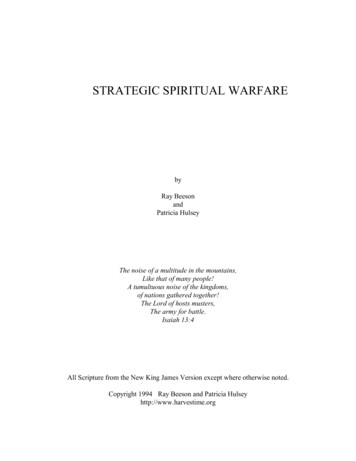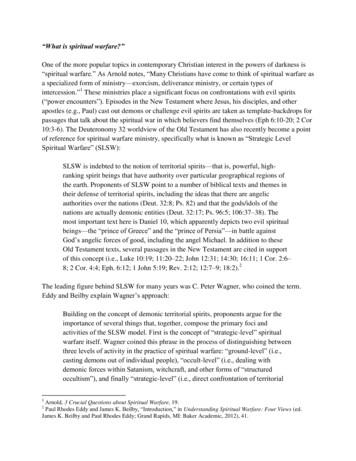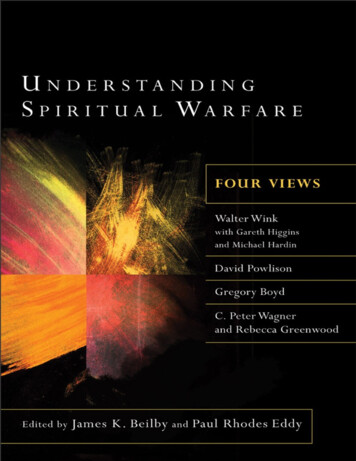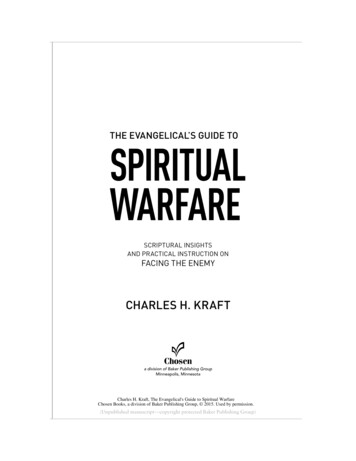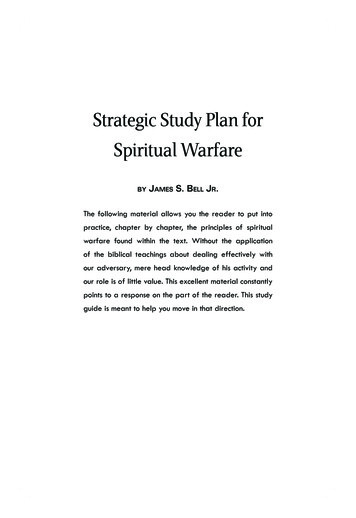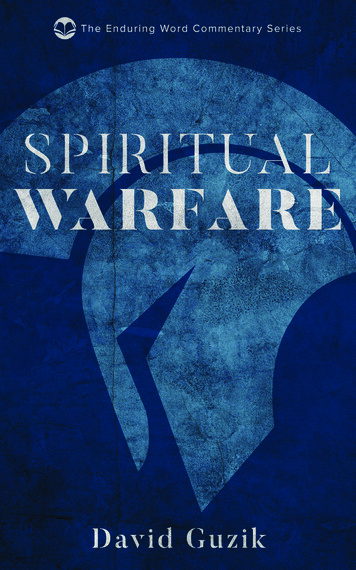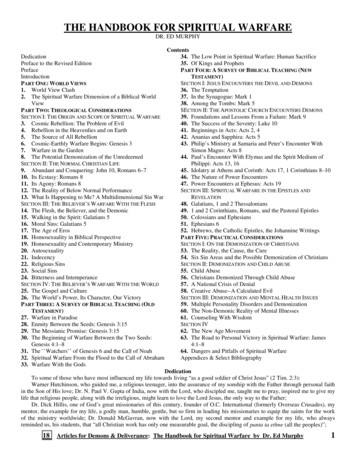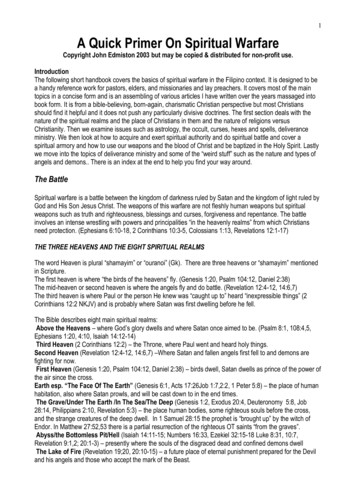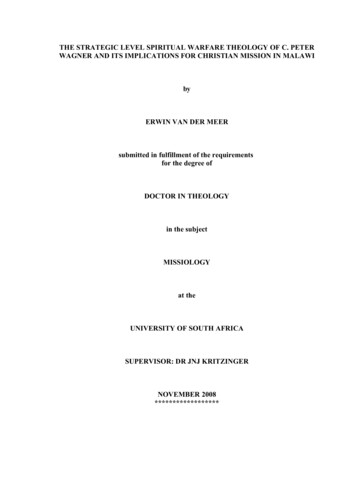
Transcription
THE STRATEGIC LEVEL SPIRITUAL WARFARE THEOLOGY OF C. PETERWAGNER AND ITS IMPLICATIONS FOR CHRISTIAN MISSION IN MALAWIbyERWIN VAN DER MEERsubmitted in fulfillment of the requirementsfor the degree ofDOCTOR IN THEOLOGYin the subjectMISSIOLOGYat theUNIVERSITY OF SOUTH AFRICASUPERVISOR: DR JNJ KRITZINGERNOVEMBER 2008******************
DECLARATIONI declare that“THE STRATEGIC LEVEL SPIRITUAL WARFARE THEOLOGY OFC. PETER WAGNER AND ITS IMPLICATIONS FORCHRISTIAN MISSION IN MALAWI”is my own work and that all the sources that I have used or quoted have been indicatedand acknowledged by means of complete references.Student:ERWIN VAN DER MEERDate
THE STRATEGIC LEVEL SPIRITUAL WARFARE THEOLOGY OFC. PETER WAGNER AND ITS IMPLICATIONS FORCHRISTIAN MISSION IN MALAWIABSTRACTStrategic level spiritual warfare has been an emerging trend within Evangelical missiologyever since C. Peter Wagner published his Spiritual Power and Church Growth (1986). Thedistinctive doctrines of Wagner’s SLSW are 1. The doctrine of territorial spirits, whichentails the belief that powerful demons control specific geographical territories and its humaninhabitants. Through a variety of spiritual warfare techniques such demons can be overcome.2. The doctrine of territorial defilement. The assumption here is that a territorial spirit canonly hold people in a location in bondage if it has obtained the legal right to do so because ofsins and evils committed in that locality in the past. Identificational repentance on behalf ofthe people living in such territories removes the legal right of the territorial spirits. 3. Thedoctrine of Strategic Level Spiritual Warfare prayer. The underlying assumption is thatterritorial spirits can only be removed by means of aggressive spiritual warfare in the form ofa variety of prayer and exorcism methods for dealing with territorial spirits. (4) The doctrineof territorial commitment. This doctrine justifies the exercise of spiritual power and authorityby modern apostles in their communities. Wagner’s missiology has been largely shaped bythe church growth movement.In his quest for better techniques to bring about massconversions Wagner, impressed by the Latin American Pentecostal churches, embracedPentecostalism and developed SLSW. However, a thorough biblical study demonstrates thatSLSW is mostly unbiblical. A study of SLSW in Church history also demonstrates thatSLSW was never accepted in orthodox Christianity. From a contextual point of view SLSWturns out to be a North American missiology with nationalist and political biases. Finally,when looking at the potential effects of a SLSW style missiology in the context of Malawi itemerges that Wagner’s SLSW is likely to reinforce rather than diminish the prevalentwitchcraft fears in the Malawian society. At the same time SLSW tends to ‘demonize’ othercultures and thus hinders genuine contextualization. In the final analysis SLSW turns out notto be a commendable strategy for Christian Mission in Malawi.
KEY TERMSStrategic level spiritual warfare; Territorial spirits; Ruler demons; Powers and Principalities;Spiritual mapping; Spiritual warfare; Warfare prayer; Prayer warriors; Identificationalrepentance; Territorial defilement; Territorial demonization; Territorial commitment; NewApostolic Reformation; Demonic strongholds
ACKNOWLEDGEMENTSMany people have assisted me in the writing of this thesis. My most special thanks go to mywife who has been very supportive and has had to put up with an ‘absent’ husband who oftenspend day and night behind the computer and his books. I am also much indebted to mypromoter Dr. JNJ Kritzinger who has been very patient as I was working on this thesis duringa very turbulent period of my life after our family was expelled from Zimbabwe and I wasunable to register for two years. I am also grateful to Dr. Steven Paas who in spite of hisbusy schedule agreed to proofread my drafts. His enthusiasm and useful recommendationshelped me to improve this thesis. I also need to mention my good friend, and Africantheologian, Fabulous Moyo. He has been a great source of encouragement and inspirationduring his visits to Malawi. I am also indebted to my friends Dr. Arie Brand, Rev. JimPfeiffer and to my former colleagues at Harare Theological College, Dr. O Ngundu and Dr.D Rousseau. They have encouraged me to specialize in the area of spiritual warfare eversince I started investigating Wagner’s missiology back in 1996. They have also helped meacquire books and articles on Strategic Level Spiritual Warfare and related topics. I am alsoindebted to Dr. Paul Bowers, who back in the 1990s during my undergraduate studiesintroduced me to the dynamics of contextualization in Africa. Finally, I want to thank myMalawian colleagues and co-workers in the gospel, in particular my good and knowledgeablecolleagues in Christian ministry, Rev. Wonder Kanyangira and Rev. Syrus Williamu of theCentral African Presbyterian Church and the Evangelical Church of Malawi respectively.They assisted me with a lot of insights concerning culture, church and religion in Malawi.There are many more people who, in one way or another, contributed to this thesis. Thoughthey cannot all be mentioned by name, I am grateful for their comments, suggestions andcorrections, many of which are incorporated in the text.Erwin van der MeerBlantyre, Malawi30 October 2008
4Table of ContentsCHAPTER 1.8INTRODUCTION.81.1. About this study.81.1.1. The focus of this study.81.1.2. Relevance of this study for Evangelical missiology.121.1.3. Review of relevant literature.211.1.3.1. Spiritual power and missions (Rommen 1995).211.1.3.2. The Holy Spirit and mission dynamics (McConnell 1997).261.1.3.3. Territorial spirits and world evangelisation? (Lowe 1998).281.1.3.4. Strategic level spiritual warfare: a modern mythology (Reid 2002).301.1.3.5. Statements of the Lausanne Congress on World Evangelisation (LCWE).341.1.3.6. An urban mission strategy for reaching entire cities with the gospel. Acritical evaluation of the prayer evangelism strategy of Ed Silvoso (Mostert 1997).401.1.3.7. Conclusions from book reviews.451.2. Personal considerations.461.2.1. My experiences in Evangelical christian mission and spiritual warfare.461.2.2. Similarities and dissimilarities in my background as compared to Wagner.471.2.3. Contours of my missiology.481.2.4. Contours of my Evangelical epistemology in a post modern world.501.3. Method of this study.561.4. Delimitation of this study.571.5. Survey of coming chapters.581.5.1. About chapter 2.581.5.2. About chapter 3.591.5.3. About chapter 4.591.5.4. About chapter 5.601.5.5. About chapter 6.601.5.6. About chapter 7.61CHAPTER 2.62THE THEOLOGICAL PILGRIMAGE OF C. PETER WAGNER.622.1. About C. Peter Wagner.62
52.2. Theological background of C. Peter Wagner.632.3. C. Peter Wagner and the Church Growth Movement.662.3.1. The Church Growth Movement and Fuller Theological Seminary.662.3.2. The Church Growth Movement and Wagner at Fuller Theological Seminary.692.3.3. The influence of Wagner in the Church Growth Movement .702.3.4. C. Peter Wagner and the Lausanne Congress for World Evangelisation.722.4. The Pentecostal paradigm shift of C. Peter Wagner.732.4.1. Church growth and Pentecostalism.732.4.2. Wagner and the 'Third Wave' movement.742.4.2.1. Wagner’s paradigm shift and the 'Third Wave' movement.742.4.2.2. The Pentecostal roots of the 'Third Wave' movement.762.4.2.3. Contours of 'Third Wave' spiritual warfare missiology.782.4.2.4. The Founders of the 'Third Wave' movement.812.4.2.5. The 'Third Wave' movement and Fuller Theological Seminary.822.5. The strategic level spiritual warfare movement.842.6. The New Apostolic Reformation.89CHAPTER 3.92STRATEGIC LEVEL SPIRITUAL WARFARE.923.1. Background of SLSW.923.1.1. Power evangelism and SLSW.923.1.2. Distinctive teachings of SLSW.943.2. Wagner’s doctrine of territorial spirits.973.2.1. The Nature of territorial spirits according to Wagner.973.2.2. Theological assumptions underlying the concept of territorial spirits.983.2.2.1. Satan is not omnipresent and needs a hierarchy of spirits under his control 983.2.2.2. Exorcism of demonic spirits is more effective if we know their names.1003.2.3. Biblical evidence for territorial spirits as presented by Wagner.1003.2.3.1. Territorial spirits in Deuteronomy 32:8.1013.2.3.2. Territorial spirits in Daniel 10:10-21.1033.2.3.3. Territorial spirits in Matthew 12:22-29.1063.2.3.4. Territorial spirits in Ephesians 6:10-18.1103.2.4. Spiritual mapping of territorial spirits.1113.2.4.1. Spiritual mapping and names of territorial spirits.111
63.2.4.2. Spiritual mapping and causes of territorial demonization.1123.2.4.3. Spiritual mapping and Pentecostal style prophecy.1153.3. Wagner’s doctrine of territorial defilement.1183.3.1. Territorial defilement and identificational repentance.1183.3.2. Evaluation of the doctrine of territorial defilement.1213.4. Wagner’s doctrine of strategic level spiritual warfare prayer.1233.4.1. The doctrine and practice of warfare prayer.1233.4.2. The SLSW assault on the territorial spirit 'Queen of Heaven'.1243.4.3. Evaluation of the doctrine and practice of warfare prayer.1263.5. Wagner’s doctrine of territorial Commitment.130CHAPTER 4.133WAGNER’S SLSW AND SPIRITUAL WARFARE IN THE BIBLE.1334.1. Introduction to spiritual warfare in the Bble.1334.2. Satan, demons and spiritual warfare in the Old Testament.1334.2.1. Satan in the Old Testament.1334.2.2. Demons and evil spirits in the Old Testament.1364.2.2.1. A general overview of demons and evil spirits in the Old Testament.1364.2.2.2. Names of demons and evil spirits in the Old Testament.1384.3. Spiritual warfare in inter-testamental Judaism.1444.3.1. Satan in inter-testamental Judaism.1444.3.2. Demons and evil spirits in inter-testamental Judaism.1474.3.3. Prayer and warfare in inter-testamental Judaism.1504.4. Spiritual warfare in the New Testament.1524.4.1. Satan in the New Testament.1524.4.2. Demons in the New Testament.1584.4.3. Prayer and spiritual warfare in the New Testament.1624.5. Evaluation of SLSW from the perspective of biblical theology.164CHAPTER 5.177STRATEGIC LEVEL SPIRITUAL WARFARE AND CHURCH HISTORY.1775.1. Wagner’s examples of strategic level spiritual warfare in church history.1775.1.1. The example of Gregory the Wonderworker .1785.1.2. The example of Martin of Tours.1805.1.3. The example of Benedict.180
75.1.4. The example of Boniface.1815.1.5 Wagner’s brief references to Justin, Irenaeus, Tertullian and Cyprian.1825.2. Evaluation of Wagner’s examples from church history .1835.3. Survey of other examples of spiritual warfare in church History.1855.3.1. Spiritual warfare in the pre-modern era.1865.3.1.1. Spiritual warfare as exorcism in the pre-modern era.1865.3.1.2. Spiritual warfare as overcoming demonic temptation in the pre-modern era.1895.3.1.3. spiritual warfare as a matter of polemics and apologetics.1935.3.2. Spiritual warfare in the modern era.1965.3.2.1. Spiritual warfare and the Protestant churches in the modern era.1965.3.2.2. Spiritual warfare and the Roman Catholic church in the modern era.1985.4. Some conclusions concerning SLSW based on the survey of church History.199CHAPTER 6.201STRATEGIC LEVEL SPIRITUAL WARFARE IN CONTEXT.2016.1. Evangelical christianity in post modern America.2016.1.1. The Evangelical crisis in the post modern America.2016.2. Wagner’s partial paradigm shift in post modern America.2056.2.1. Wagner initial shift from cessationism to non-cessationism.2056.2.2. Wagner’s epistemological shift.2076.3. The development and spread of SLSW in the North American context.2116.3.1. A brief survey of Evangelicalism in North America.2116.3.2. Dispensationalism in North America and the political right.2146.3.3. Dispensationalism in North America and spiritual warfare.2156.3.4. Dispensationalism in North America and SLSW.2186.4. SLSW and North American right-wing political interests.2206.5. SLSW and other Christian traditions.2256.6. SLSW and other religions.2266.7. SLSW and social transformation.2306.8. Some conclusions concerning SLSW and Christian mission.2326.8.1. Why SLSW is not a wholesome strategy for Christian mission.2326.8.2. The need for a biblical approach to spiritual warfare in Christian mission.2356.8.3. The need for a contextual approach to spiritual warfare in Christian Mission.239
8CHAPTER NIN MALAWI.2477.1. The Need for a contextually relevant approach to witchcraft in Malawi.2477.2. The problem of the fear of witchcraft.2497.3. Various approaches in addressing the problem of the fear of witchcraft in Malawi.2527.3.1. An evolutionary approach.2527.3.2. The approach of African Pentecostalism.2557.3.3. Wagner’s SLSW approach.2587.3.4. An alternative approach to the fear of witchcraft.259Appendix A.269A Working Group Report.269Appendix B.274Deliver Us From Evil Consultation Statement.274Introduction.274Origins.275Common Ground.276Theological Affirmations.276Spiritual Conflict in Practice.279Warnings.282Areas of Tension.284Frontiers That Need Ongoing Exploration .285Notes: .287BIBLIOGRAPHY.288ABBREVIATIONS.310
9THE STRATEGIC LEVEL SPIRITUAL WARFARE THEOLOGY OFC. PETER WAGNER AND ITS IMPLICATIONS FOR CHRISTIANMISSION IN MALAWICHAPTER 1INTRODUCTION1.1. About this study1.1.1. The focus of this studyThis study is a critical evaluation of the strategic level spiritual warfare theology (SLSW) ofC. Peter Wagner and its implications for Christian Mission in Malawi. Wagner is a wellknown Evangelical missiologist and a former professor of church growth and Missions at theSchool of World Missions of Fuller Theological Seminary in Pasadena, California. Wagner’smain thesis in SLSW is that if the church through prayer can overcome supernatural demonicresistance to the Gospel presented by territorial spirits or demons, world evangelism will bemore successful in reaching the lost:‘The real battle for both world evangelisation and social justice is a spiritual battleand our principal weapon of spiritual warfare is prayer’ (Wagner 1993c:200)1.The subject of spiritual warfare is not new in the history of Christian mission, but itsunderstanding has changed over the ages and rather drastically in the latter half of the 20thcentury, particularly within the context of the ‘AD2000 and Beyond’ movement (Hoole1998:45). The most recent spiritual warfare method is called strategic level spiritual warfare(SLSW) and has made considerable inroads within Evangelicalism, especially amongPentecostals2. The proponents of SLSW assume the existence of territorial spirits, a special1The emphasis expressed by 'bold' print is Wagner's.Notwithstanding the differences in understanding concerning the baptism in the Holy Spirit and the necessityof speaking in tongues as a sign of such spirit baptism, I classify so-called ‘Charismatics’ and so-called ‘Third2
10class of demons, which presumably hold neighbourhoods, cities and other territories inspiritual darkness so that the Gospel cannot penetrate (Wagner 1989:278ff; 1991:130ff).Wagner is the main proponent of SLSW. Though Wagner is not the first person to advocateSLSW style spiritual warfare, he is by far the most prolific author and most influentialadvocate of SLSW.Wagner’s main critics point out that he and his fellow SLSWmissiologists have unwittingly incorporated magical and animistic notions of spirit powerwhich are at odds with biblical teaching (Priest, Campbell and Mullen 1995:11-12). Anotheraspect hardly discussed among Evangelical missiologists is that Wagner’s SLSW hasremarkable similarities with American war theory and practices.War planners at thePentagon discussing the war in Afghanistan have reportedly stressed two essentials ofaccurate intelligence: Ascertain the identity and whereabouts of the enemy. Next accurateintelligence needs to be followed up by the use of superior warfare technology (Steinkamp2006). Wagner’s SLSW relies on these same two warfare principles - specific intelligence ofthe spirit world and new spiritual methodologies which purport to neutralise or destroyenemies in the spirit world. spiritual mapping provides the accurate intelligence so that astrategic war plan can be drawn like the smart bombs of the USA army and its allies againstSaddam Hussein (Beckett 1993:158-159). All of this is designed to ensure victory inevangelism and to transform communities as the sin-causing demons are overcome throughSLSW (Steinkamp 2006).Wagner, as the main architect of SLSW, also called spiritual warfare Evangelism, hasbecome its undisputed leader (Steinkamp 2006). Apart from Wagner there are various otherinfluential players of international reputation in the field of SLSW such as George Otis, Jr,Charles Kraft, Cindy Jacobs, Ed Silvoso and others (Jacobs 1991, 1995; Kraft 2002:13ff; Otis1993, 1999, 2000; Wagner 2000e:9-11).3 There is, however, considerable similarity in theirapproach to SLSW. According to Wagner, they often write and work very closely togetherand all of them have written contributions in Wagner’s SLSW readers (Wagner & Deiros1998; Wagner 1990; 1991; 1993). Also the various authors frequently quote one another'swritings, and consequently most of what can be said about Wagner’s approach to SLSW willWave’ Evangelicals as Pentecostals (Erickson 1985:836). All of these groups emphasize the supernatural giftsof the Holy Spirit including healing, speaking in tongues, prophecy and exorcism and there is very closeinteraction and exchange of ideas and speakers between the groups with C. Peter Wagner being influential in allof them.3See Cindy Jacobs’ Possessing the Gates of the Enemy (Jacobs 1991), Charles H. Kraft’s Defeating DarkAngels (Kraft 1992), Ed Silvoso’s That None Should Perish (1994), The Last of the Giants (Otis 1991), and theTransformations video (Otis 1999), by George Otis jr.
11also apply to them (Wagner 1991; 1992:163-164; 171; 1997b:116-118). Virtually all of theinfluential SLSW proponents have been students or participated as co-lecturers in Wagner’scourses in School of World Missions at Fuller Theological Seminary in Pasadena,California.4 For example Cindy Jacobs calls Peter Wagner her mentor and writes that Wagnerand his wife assisted her in writing her book (Jacobs 1991:7). Wagner calls Cindy Jacobs aclose personal friend and made all his students at Fuller Theological Seminary read her book(Wagner in Jacobs 1991:12-14). Charles H. Kraft has been a close colleague of Wagner andwas together with him closely associated with John Wimber, who himself at one time wasWagner’s student and then became his associate (Kraft 2002:13-15; Wimber in Wagner et al.1983:14-15; Wagner et al. 1983:10-11, 40-41). George Otis Jr, was a member of the spiritualwarfare network of which Wagner was the coordinator. George Otis Jr, was also hand-pickedby Wagner to be his co-coordinator of the AD 2000 Movement United Prayer Track and leadits spiritual mapping division (Wagner 1993:12; 1993:b215-218; 1996a:20-21). For thepurposes of this thesis, other proponents and authors on SLSW will occasionally be referredto, but my primary focus is on Wagner as I consider him the chief architect, advocate andmost influential proponent of SLSW.In addition, I also consider Wagner’s academicprestige, his popular appeal within a large segment of Evangelicalism, and lastly his manybooks and articles on SLSW subject matter.5The new spiritual warfare movement characterized by SLSW has been increasing inpopularity as a new strategy for Christian mission and evangelism among Evangelicalsaround the globe, including the African continent (Chiundiza 1991:121-127; Gaines 2000:7780; Freston 2001; Leithgöb 1996). At various major international Evangelical mission eventsand consultations SLSW was discussed and promoted, particularly through the channels ofthe ‘AD 2000 and Beyond’ movement of the Lausanne Committee for World Evangelisation(Wagner 1996a:249-256).Consequently, SLSW drastically changed the way manyEvangelicals think about, and get involved in, the spread of the Gospel, with SLSW more and4Fuller Theological Seminary was co-founded by Dispensationalist theologian and radio evangelist Charles E.Fuller together with Presbyterian pastor and educator H. J. Ockenga in 1947 in order to give graduate students aconservative Christian education in theology and to promote evangelism and world missions (Douglas1995:146-147; 282).5Wagner has written more than 25 books directly or indirectly related to SLSW (1986, 1989, 1990, 1991,1992a, 1992b, 1993a, 1993b, 1993c, 1994, 1995a, 1995b, 1996a, 1997a, 1997b, 1999a, 1999b, 2000a, 2000b,2000c, 2000d, 2001a, 2001b, 2001c, 2002), and so many articles in journals, magazines and newsletters thatWagner himself could not even recall them as he indicated in an email reply to the author's request.
12more taking center stage in mission and evangelism (Hart 1997; Lowe 1998: 11-13; Moore1998:55).I became personally
theologian, Fabulous Moyo. He has been a great source of encouragement and inspiration during his visits to Malawi. I am also indebted to my friends Dr. Arie Brand, Rev. Jim Pfeiffer and to my former colleagues at Harare Theological College, Dr. O Ngundu and Dr. D Rousseau. They have encouraged me to specialize in the area of spiritual warfare ever since I started investigating Wagner's .


